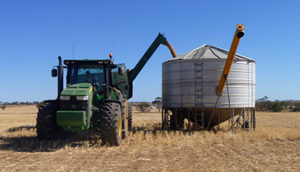Read the latest information on
Foot-and-mouth disease

Grains Biosecurity Officer, Kym McIntyre, says their are five questions you should ask your harvest contractor.
The movement of harvest contractors and machinery between farming regions during harvest can spread diseases, pests and weeds.
“While harvest contractors provide valuable services, you need to be aware of the biosecurity risks they might pose,” says Queensland Grains Biosecurity Officer Kym McIntyre.
“There are five questions you can ask to identify potential issues before your harvest contractor enters your property.”
Kym says it is important to know where the contractor last worked so you can keep an eye out for any pest or weed issues present in that area that aren’t found in yours.
“Having records of movements to and from the property in a register of visitors is an effective tool in tracing any potential spread of pests,” she says.
Kym recommends finding out what specific threats might have been present on the property, such as any hard-to-kill or herbicide-resistant weeds.
“By asking what the potential risks are, you will know what to look out for if anything unusual appears in your crop.”
“If they were harvesting the same crop, or a crop that has similar pests to yours, they could be accidentally carrying pests your crop is vulnerable to in their vehicles and equipment,” she says.
“Alternatively, if they were harvesting a different crop, you don’t want grain to contaminate your harvest. After you have asked what the potential problems might be, it is also important to check what has been done to minimise these risks.”
Kym recommends asking your contractor to clean their vehicles and equipment before they arrive on the property.
“Soil and plant material can carry weed-seeds and pests when left on tyres, radiator grilles, wheel arches, floor mats and work boots. Make sure you check any machinery or vehicles that are going to be working on your farm and remember that if you are not satisfied with their cleanliness, you can direct them to your vehicle clean-down station or a designated area which can be monitored.”
“Even a small amount of grain residue left behind in equipment between harvests can allow insects to breed and go on to infest freshly harvested grain. As it is difficult to remove all grain residue from harvest equipment without a major overhaul, it is recommended to run a diatomaceous earth treatment, such as Dryacide, through the harvester or handling equipment. The fine particles of the treatment get into the joints of the insect, irritating their waxy exoskeleton and causing them to die of dehydration.”
For more information, contact Kym McIntyre, kym.mcintyre@daf.qld.gov.au, 0429 727 690
Acknowledgement: reproduced from an article in the Grains Research and Development Corporation’s Ground Cover magazine